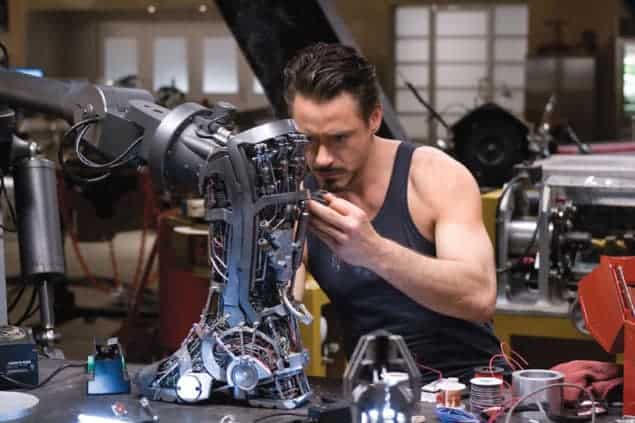Lab Coats in Hollywood: Science, Scientists and Cinema
David Kirby
2011 MIT Press £19.95/$27.95hb 280pp

Public outreach has long been a central component of the scientific enterprise. In the 19th century, travelling lecturers gave public scientific talks and demonstrations to general audiences – Michael Faraday’s 1860 “Christmas lecture” on the chemistry of candles being a notable early example. This tradition continued in the early days of radio (when audiences familiar with on-air interviews with real scientists found Orson Welles’ fictional War of the Worlds broadcast all too convincing) and moved on to television in the 1950s with programmes such as Mr Wizard, as scientists sought new ways of using mass-communication technology to reach a broader audience. Today, outreach-minded scientists have another option for communicating science and the scientific method: they can become consultants on big-budget Hollywood films.
A scientist who consults for a science-fiction or superhero film can easily reach an audience of millions – far more than will ever read the research papers he or she publishes in refereed journals. Hollywood’s demand for such consultants has increased in the past few years and the scientific community has responded. In the US alone, there are now two separate groups that aim to match academics with film and television creators: the National Academy of Sciences’ Science and Entertainment Exchange and the National Science Foundation’s Creative Science Studio. But are such arrangements beneficial for science? What is driving Hollywood’s interest in the opinions of scientists, and what do the scientists get out of it? And what are the advantages and pitfalls of this deal?
These questions are addressed in Lab Coats in Hollywood: Science, Scientists and Cinema by David Kirby. A senior lecturer in science communication studies at the University of Manchester, UK, Kirby has written that rare book: a scholarly work at the intersection of popular culture and serious science that is accessible and highly readable. In it, he provides a thorough history of the ways scientists have assisted filmmakers, beginning with Fritz Lang’s 1929 Woman in the Moon, which employed rocket-science pioneers Hermann Oberth and Wernher von Braun as consultants.
To uncover this history, he has interviewed an admirably broad cross-section of participants on both sides of the academia/Hollywood divide, including Jack Horner, paleontology consultant for the Jurassic Park films; the makers of the 1998 comet thriller Deep Impact and the scientists they relied upon; and Alex McDowell, production designer for Minority Report and Watchmen. (Disclosure: he also interviewed me, since I was one of the first participants in the Science and Entertainment Exchange programme and I have worked pro bono as a consultant for the Warner Bros films Watchmen, Green Lantern and next year’s The Amazing Spider-Man.)
Hollywood’s interest in telling engaging stories has brought filmmakers to the halls of academia because some of them realize that if the audience is noticing an egregious scientific blooper, or thinking that the scene they are watching is not an accurate representation of a real laboratory, they are not paying attention to the story. This can be fatal for science-fiction and superhero films, where it is crucial that once the audience has suspended disbelief and bought into the film’s fantastic premise, they are not subsequently jolted by obvious bad science.
Kirby documents various small ways that scientists can help filmmakers avoid such jolts, including making sure the set of a biological science lab contains a box of KimWipes. One of my favourite examples of little things “ringing true” is a scene in Iron Man (2008) where the actor Robert Downey Jr – playing the industrialist genius Tony Stark – is constructing a hi-tech suit of armour in his basement laboratory. We see Downey doing soldering on the suit – and he is doing it right, using the same soldering iron I have in my own condensed-matter physics laboratory. Although I am probably the only person who saw Iron Man and applauded the soldering, such attention to detail is necessary when creating a believable fake reality. Leave it out, and the audience may find it harder to accept that they are watching Stark create his superhero suit, and not Downey playing a role.
Scientists can also get involved in bigger issues, such as helping with script development. With Deep Impact, the filmmakers brought together a team of scientists to provide as much realistic information as possible, and their extensive and substantial suggestions were, for the most part, incorporated into the film. In contrast, the director Michael Bay mostly ignored the advice of his science consultant on Armageddon, a similar meteor-impact adventure that came out the same year. As a result, Bay’s film is riddled with bad science, though sadly this does not appear to have hurt it at the box office – demonstrating that, ultimately, engaging visuals and dramatic storytelling can trump scientific accuracy.
So what do the scientists get out of being consultants? Kirby’s answer is that interactions with Hollywood provide not only personal exposure and enhanced outreach opportunities, but sometimes also a chance to shift the terms of a scientific debate. Jack Horner’s proposals about the common ancestry of dinosaurs and birds, for instance, were controversial among paleontologists back in 1993, but you would not know it from watching the first Jurassic Park film, which treated his theory (more or less) as established fact. Similarly, the experts who consulted on Deep Impact disagreed about the appearance of a comet’s surface, the intensity of its outgassing and the size of debris in its coma; inevitably, the filmmakers went with the answers that made for more dramatic visuals. In some cases, Hollywood exposure can even help scientists bring about new technologies, such as space travel or virtual reality, using films as a vehicle to get public opinion behind increased research funding or better preparation for a deadly contagion. Such silver-screen arguments can reach more people and be much more persuasive than those that come from, say, NASA or the Center for Disease Control.
In the best-case scenario, as Kirby states, “scientists…can help filmmakers craft images and narratives that convey the excitement of scientific research or communicate a sense of awe about the natural world”. Crucially, it is in scientists’ interest to help bring about this best-case scenario, since less-credible “authorities” wait in the wings. It may be frustrating, though understandable, when sound scientific advice is ignored in favour of exciting visual story-telling, but as Kirby points out near the end of Lab Coats, the alternative is to leave the job to “individuals involved in fringe pseudo-sciences such as cryptozoology, UFOlogy and parapsychology [who] have jumped at the chance to consult on films”. Kirby makes a strong case that this predominant form of mass communication gives scientists the power to effect real, positive change in the public’s opinion of scientific research. And from the Spider-Man films, we all know what comes with great power.



